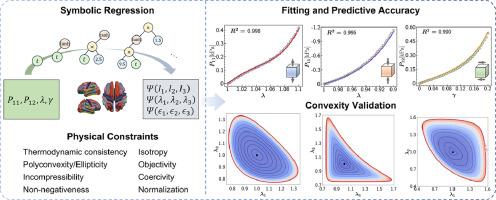基于符号回归的材料模型自动数据驱动发现:人类大脑皮层案例研究。
IF 9.4
1区 医学
Q1 ENGINEERING, BIOMEDICAL
引用次数: 0
摘要
我们介绍了一种数据驱动框架,用于从稀疏数据中自动识别可解释且具有物理意义的超弹性构造模型。利用符号回归,我们的方法能生成优雅的超弹性模型,这些模型能以简洁的数学公式实现精确的数据拟合,同时严格遵守多凸性/椭圆性等超弹性约束条件。我们的研究涵盖了三种不同的超弹性模型--基于不变性、基于主拉伸和基于法向应变,并突出了符号回归的多功能性。我们使用五个经典超弹性模型的合成数据和人类大脑皮层的实验数据验证了我们的新方法,以证明算法的有效性。结果表明,我们的符号回归算法在基于不变式、基于拉伸和基于应变的情况下,都能以简洁的数学表达式稳健地发现准确的模型。引人注目的是,基于应变的模型表现出更高的准确性,而基于拉伸和基于应变的模型都能有效捕捉到人类脑组织固有的非线性和拉伸-压缩不对称。多凸性/椭圆性评估肯定了在训练机制内外对凸性要求的严格遵守。然而,基于拉伸的模型引起了对大变形情况下可能出现的凸度损失的担忧。对预测能力的评估表明,所有三种模型都具有出色的内插能力,而基于拉伸和应变的模型的外推性能也是可以接受的。最后,对噪声嵌入数据的稳健性测试强调了我们的符号回归算法的可靠性。我们的研究证实了符号回归在自动发现人脑各向同性超弹性模型中的适用性和准确性,并为其他软物质系统提供了广泛的应用前景。意义说明:我们的研究引入了一个开创性的数据驱动框架,彻底改变了超弹性结构模型的自动识别,尤其是在人脑等软物质系统中。通过利用符号回归的力量,我们释放了将错综复杂的物理现象提炼成优雅、可解释的数学表达式的能力。我们的方法不仅能确保对稀疏数据的精确拟合,还能维护关键的超弹性约束,包括对保持物理相关性至关重要的多凸性。本文章由计算机程序翻译,如有差异,请以英文原文为准。

Automated data-driven discovery of material models based on symbolic regression: A case study on the human brain cortex
We introduce a data-driven framework to automatically identify interpretable and physically meaningful hyperelastic constitutive models from sparse data. Leveraging symbolic regression, our approach generates elegant hyperelastic models that achieve accurate data fitting with parsimonious mathematic formulas, while strictly adhering to hyperelasticity constraints such as polyconvexity/ellipticity. Our investigation spans three distinct hyperelastic models—invariant-based, principal stretch-based, and normal strain-based—and highlights the versatility of symbolic regression. We validate our new approach using synthetic data from five classic hyperelastic models and experimental data from the human brain cortex to demonstrate algorithmic efficacy. Our results suggest that our symbolic regression algorithms robustly discover accurate models with succinct mathematic expressions in invariant-based, stretch-based, and strain-based scenarios. Strikingly, the strain-based model exhibits superior accuracy, while both stretch-based and strain-based models effectively capture the nonlinearity and tension-compression asymmetry inherent to the human brain tissue. Polyconvexity/ellipticity assessment affirm the rigorous adherence to convexity requirements both within and beyond the training regime. However, the stretch-based models raise concerns regarding potential convexity loss under large deformations. The evaluation of predictive capabilities demonstrates remarkable interpolation capabilities for all three models and acceptable extrapolation performance for stretch-based and strain-based models. Finally, robustness tests on noise-embedded data underscore the reliability of our symbolic regression algorithms. Our study confirms the applicability and accuracy of symbolic regression in the automated discovery of isotropic hyperelastic models for the human brain and gives rise to a wide variety of applications in other soft matter systems.
Statement of significance
Our research introduces a pioneering data-driven framework that revolutionizes the automated identification of hyperelastic constitutive models, particularly in the context of soft matter systems such as the human brain. By harnessing the power of symbolic regression, we have unlocked the ability to distill intricate physical phenomena into elegant and interpretable mathematical expressions. Our approach not only ensures accurate fitting to sparse data but also upholds crucial hyperelasticity constraints, including polyconvexity, essential for maintaining physical relevance.
求助全文
通过发布文献求助,成功后即可免费获取论文全文。
去求助
来源期刊

Acta Biomaterialia
工程技术-材料科学:生物材料
CiteScore
16.80
自引率
3.10%
发文量
776
审稿时长
30 days
期刊介绍:
Acta Biomaterialia is a monthly peer-reviewed scientific journal published by Elsevier. The journal was established in January 2005. The editor-in-chief is W.R. Wagner (University of Pittsburgh). The journal covers research in biomaterials science, including the interrelationship of biomaterial structure and function from macroscale to nanoscale. Topical coverage includes biomedical and biocompatible materials.
 求助内容:
求助内容: 应助结果提醒方式:
应助结果提醒方式:


